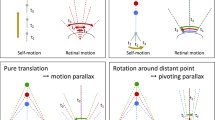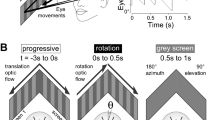Summary
In his discussion of the optomotor behaviour Kalmus claimed in 1964 that the visual systems of insects continuously resolve horizontal displacements relative to the surroundings into rotatory and translatory components, each associated with optomotor feedback of particular quality and sign. The feedback is supposed to achieve, simultaneously, minimization of the rotatory movements and maximization of the translatory movements, a behaviour repeatedly observed with actively moving insects such as the fruitflyDrosophila melanogaster.
The present approach takes into account that the output of movement detectors in the visual system of insects is necessarily equivocal with respect to the speed of the stimulus (e.g. zero output at both zero and infinite speed). Decomposition of the stimulus is not feasible under these conditions. It is obviously the composite stimulus to which the insects respond. Moreover, there is experimental evidence that optomotor feedback on the translatory movement is not necessarily a response-determining factor in insects. The optomotor behaviour of the walking fruitfly is sufficiently described by the sum of itsrotatory responses to the composite stimuli on either side.
A diagram representing the expected rotatory response of the walking fruitfly as a function of both the rotatory and the translatory stimulus component is used to derive the prevailing traits of the behaviour in resting, rotating and floating environments, respectively. Most conspicuous is the inversion of the course-control response in about one half of the possible states of stimulation. This effect gives rise to at least some of the apparently spontaneous turns of actively moving insects which have been ascribed by v. Holst and Mittelstaedt to efferent commands from higher centres of the brain, according to their principle of reafference. The present results merely disprove the necessity of these commands. Inversion of the response is also an inherent property of the course-control systems of the optomotorically active insects. The expected increase of these inversions with closer proximity of the visual environment is found by observation of walking fruitflies.
The relation between the rotatory and translatory movements of the freely walking fly and its state of stimulation in a given environment is used to describe the expected behaviour in terms of the most probable transition of state. The approach is based on estimates of the power required by the fly in order to maintain a given state against the torque that is produced by its course-control system in response to the optomotor stimulation. The most probable transition of state is apparently determined by the tendency of the fly to decrease the power requirement by appropriate adaptation of its rotatory movement. The transition may come to an end in one of the states of minimum power requirement where the speed of the rotating fly is held in a stable optomotor equilibrium.
Similar content being viewed by others
References
Benzer, S.: (unpublished)
Gavel, L. v.: Die “kritische Streifenbreite” als Maß der Sehschärfe beiDrosophila melanogaster. Z. vergl. Physiol.27, 80–135 (1939)
Götz, K. G.: Optomotorische Untersuchung des visuellen Systems einiger Augenmutanten der FruchtfliegeDrosophilia. Kybernetik2, 77–92 (1964)
Götz, K. G.: Flight control inDrosophilia by visual perception of motion. Kybernetik4, 199–208 (1968)
Götz, K. G.: Fractionation ofDrosophila populations according to optomotor traits. J. exp. Biol.52, 419–436 (1970)
Götz, K. G.: Principles of optomotor reactions in insects. Bibl. ophthal. (Basel)82, 251–259 (1972a)
Götz, K. G.: Processing of cues from the moving environment in theDrosophila navigation system. In: Information processing in the visual system of Arthropods, ed. R. Wehner, p. 255–263. Berlin-Heidelberg-New York: Springer 1972b
Götz, K. G., Wenking, H.: Visual control of locomotion in the walking fruitflyDrosophila. J. comp. Physiol.85, 235–266 (1973)
Hecht, S., Wald, G.: The visual acuity and intensity discrimination ofDrosophila. J. gen. Physiol.17, 517–547 (1934)
Heisenberg, M.: Comparative behavioural studies on two visual mutants ofDrosophila. J. comp. Physiol.80, 119–136 (1972)
Heisenberg, M., Götz, K. G.: The use of mutations for the partial degradation of vision inDrosophila melanogaster. J. comp. Physiol.98, 217–241 (1975)
Horn, E., Wehner, R.: The mechanism of visual pattern fixation in the walking fly,Drosophila melanogaster. J. comp. Physiol., in press (1975)
Kalmus, H.: The optomotor responses of some eye mutants ofDrosophila. J. Genet.45, 206–213 (1943)
Kalmus, H.: Optomotor responses inDrosophila andMusca. Physiol. Comp. ('s Grav.)1, 127–147 (1949)
Kalmus, H.: Animals as mathematicians. Nature (Lond.)202, 1156–1160 (1964)
Land, M. F., Collett, T. S.: Chasing behaviour of houseflies (Fannia canicularis). J. comp. Physiol.89, 331–357 (1974)
Meyer, H. W.: Spontane Formbevorzugung bei Fliegen. (In preparation)
Mittelstaedt, H.: Reafferenzprinzip — Analogie und Kritik. In: Vorträge der Erlanger Physiologentagung 1970, ed. W. D. Keidel, K.-H. Plattig. Berlin-Heidelberg-New York: Springer 1971
Mittelstaedt, H., Holst, E. v.: Reafferenzprinzip und Optomotorik. Zool. Anz.151, 253–259 (1953)
Poggio, T., Reichardt, W.: A theory of the pattern induced flight orientation of the flyMusca domestica. Kybernetik12, 185–203 (1973)
Reichardt, W.: Musterinduzierte Flugorientierung, Verhaltens-Versuche an der FliegeMusca domestica. Naturwissenschaften60, 122–138 (1973)
Reichardt, W., Poggio, T.: A theory of the pattern induced flight orientation of the flyMusca domestica. II. Biol. Cybernetics18, 69–80 (1975)
Reichardt, W., Wenking, H.: Optical detection and fixation of objects by fixed flying flies. Naturwissenschaften56, 424–425 (1969)
Wehner, R.: Spontaneous pattern preferences ofDrosophila melanogaster to black areas in various parts of the visual field. J. Insect Physiol.18, 1531–1543 (1972)
Wehner, R., Gartenmann, G., Jungi, T.: Contrast perception in eye colour mutants ofDrosophila melanogaster andDrosophila subobscura. J. Insect Physiol.15, 815–823 (1969)
Wehner, R., Wehner, S.: Calculation of visual receptor spacing inDrosophila melanogaster by pattern recognition experiments. J. comp. Physiol.82, 165–177 (1973)
Zimmermann, G.: Der Einfluß stehender und bewegter Musteranteile auf die optomotorische Reaktion der FliegeDrosophila. Thesis. Tübingen 1973
Author information
Authors and Affiliations
Additional information
Dr. E. Buchner, Prof. R. DeVoe, Dr. M. Heisenberg, Prof. W. D. Kaplan, Prof. W. L. Pak, Dr. T. Poggio and Prof. W. Reichardt have contributed to this work by numerous suggestions and important comments. Furthermore, I acknowledge with gratitude the valuable assistance in the preparation and evaluation of the experiments and in the calculation of the state diagrams by Mrs. B. Hengstenberg, Miss A. Huth and Mr. U. Wandel, the elaboration of the drawings by Mr. E. Freiberg, and the typing of the manuscript by Mrs. E. Gomaá and Miss G. Kurz.
Rights and permissions
About this article
Cite this article
Götz, K.G. The optomotor equilibrium of theDrosophila navigation system. J. Comp. Physiol. 99, 187–210 (1975). https://doi.org/10.1007/BF00613835
Received:
Issue Date:
DOI: https://doi.org/10.1007/BF00613835




